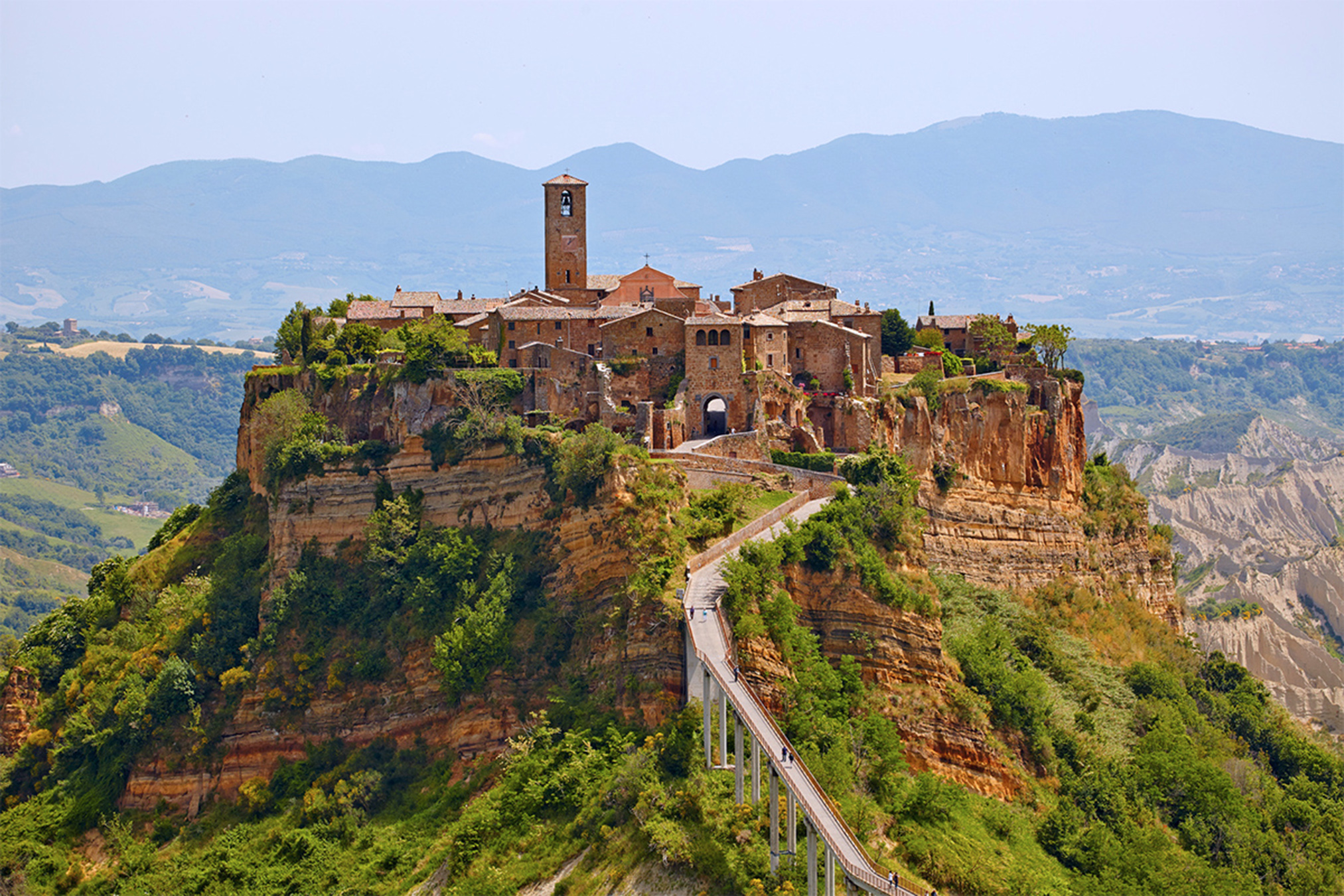Within the region of Lazio, green landscapes and enchanting medieval villages characterize Tuscia and its capital, Viterbo. Tuscia is the name of the territories that came under Etruscan influence. Although now the name refers to the province of Viterbo, the territory used to include what is now the entire region of Tuscany, a great part of Umbria, as well the northern parts of Lazio.
A sandy shoreline characterizes the area of the coast and crystalline waters of the Tyrrhenian Sea. Among the coastal destinations, Tarquinia Lido is a popular destination for those from the region, but only a few miles inland, visitors will find the Etruscan Necropolises of Cerveteri and Tarquinia, a UNESCO heritage site. These two large Etruscan cemeteries reflect the different types of burial practices of these ancient people, from the 9th to the 1st century BC. Some of the tombs are monumental, cut in rock and topped by impressive burial mounds. Many feature carvings on their walls, while others have wall paintings of outstanding quality. The necropolis near Cerveteri, known as Banditaccia, contains thousands of tombs and is laid out in a city-like form with streets and plazas. Ancient Tuscia is still shrouded in mystery, as is much of the Etruscan civilization. Many archaeological finds unearthed during excavations here are kept in the Museo Archeologico Nazionale (National Archaeological Museum), housed in Palazzo Vitelleschi in the town of Tarquinia. It is considered to be one of the most important Etruscan museums in the world.
To the east lies the ancient city of Viterbo, surrounded on both sides by the majestic peaks of Monti Cimini and Monti Volsini. First inhabited by the Etruscans in 800 BC, after the rise of the Roman Empire in the third century BC, the city truly began to flourish. The Romans built the Via Cassia, linking the region of Lazio and the city of Viterbo to the Eternal City, located 60 miles to the south.
Viterbo is known as the City of the Popes. It was the Papal seat between 1257 and 1281, moved from Rome by Alessandro IV. The city was also home to more than 40 Popes and their courts throughout the Middle Ages and Renaissance periods. The Palace of the Popes is the most important monument of the city. Completed in 1267, its elegant loggia is a Gothic architectural gem made of “Peperino” stone.
The Hall of the Conclave is where the longest election of a Pope in history was carried out. The elections lasted a total of 1,006 days, between 1268 and 1271. Eventually, the exasperated people of Viterbo removed the roof and rationed supplies to the Cardinals to try to move the election along. Once they were reduced to a diet of bread and water, they selected Gregorio X as Pope, after just three days.
But the Viterbesi were once again infuriated by the actions of the Church, this time upon the election of a non-Italian – Martino IV, born Simon de Brie in France. Together with the King of Naples, the citizens invaded the cathedral where the Papal Conclave was held and arrested two of the Cardinals who were subsequently excommunicated. Afterwards, the Popes avoided Viterbo for 86 years. Without the Popes, the city fell into the hands of the tyrannical Di Vico family and Viterbo’s glorious period ended. Viterbo remained deeply strained until it officially joined the Republic of Italy in 1871.
Just outside of Viterbo is the gracious Villa Lante at Bagnaia, designed by Giacomo Barozzi da Vignola and Bomarzo. The villa is credited as one of the most famous 16th century Mannerist gardens in Italy.
In the northwestern portion of the province is Civita di Bagnoregio, known as Italy’s Jewel on the Hill. Rising from the surrounding hills, it is a majestic sight in the skyline and dominates the wide desolate valley. This isolation is the result of a continuous erosion that has made the tufa rock become thinner and thinner on an unstable layer of clay and sand altered by wind and rain. Today, Civita is quite difficult to get to, but such was not the case when the town was founded by the Etruscans about 2,500 years ago. In fact, during the Etruscan period, it was an important city because of its position along an ancient road connected to a dense network of trade routes.
Remnants of past civilizations can be found everywhere, such as inside the cave of Saint Bonaventure, an ancient Etruscan chamber tomb transformed into a chapel during the Middle Ages. Saint Bonaventure is one of the most important figures of Civita, who, according to legend, was miraculously cured from a serious illness by St. Francis of Assisi. Civita and Bagnoregio were parts of the same city called Balneum Regis, meaning “The Bath of the King.” This name was given by the Lombard King Desiderious, when his wounds were cured by the waters of the hot springs present in the area. In 774, as the Lombards were defeated by the Franks, the city was taken over by the Papal State. Among the lords who ruled the town were the Monaldeschi, who were also lords of Orvieto. Relations between Civita and Orvieto were not always peaceful. The boundaries between the two were the cause of frequent hostilities among the inhabitants of the towns. Furthermore, the Monaldeschi wanted to preserve their control over Civita as a strategic place in the religious conflicts against Viterbo. This control soon became a real dominion until 1457, when the people rebelled, destroying the Fortress of Cervara which belonged to the Monaldeschi. As a reminder of this victory, the sculptures of two lions grasping human heads were put over the gate of Santa Maria.





